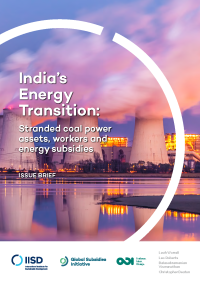India’s Energy Transition: Stranded coal power assets, workers and energy subsidies

This issue brief takes a detailed look at why such a large share of coal power is struggling today and the
structural drivers—including subsidies—that may cause similar crises to rear their heads in future. In
light of this, it sets out some broad proposals from international literature on the topic of “just transition,”
which encourages governments to recognize stranded workers and communities as much as stranded
private or public assets. Key findings:
- The current asset-stranding crisis may or may not be a sign of a deeper shift in India’s energy sector, but our review suggests that numerous drivers are pointing in this direction in the medium term. This makes the crisis also an opportunity to discuss the appropriate role for government interventions to ensure a managed transition and the appropriate support when there is a risk of stranded assets.
- The cost of coal-based power production will be shaped by both current and future drivers of asset stranding. Current drivers include coal shortages and financial distress of energy distribution companies (DISCOMs), with future risks including water scarcity, air pollution regulations and cost-competitiveness of renewables. Future studies must include a review of key regions such as Chhattisgarh, Odisha and Jharkhand, where assets are already most stressed.
- It is important to identify and evaluate the role of current policy support mechanisms for coal, which are already artificially dampening market signals across the key drivers that affect coal power costs. These take the form of subsidies, public finance through loan preferential rates, or the delay or lack of enforcement of policies (such as air pollution regulations) that would otherwise increase costs to producers.
- As part of an ongoing dialogue about labour in the coal sector, policy-makers should consider the complementary policies that can ensure that the burden of asset stranding does not fall on workers and communities. This might include general employment schemes, targeted social protection measures and financing mechanisms. These should be developed through deep engagement with workers and communities.

